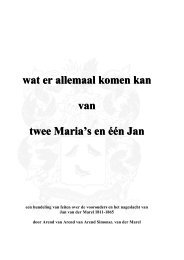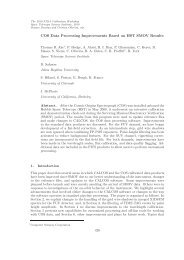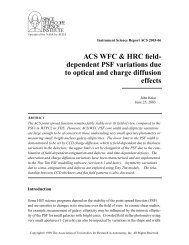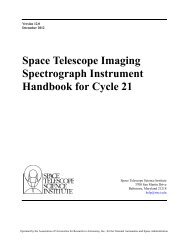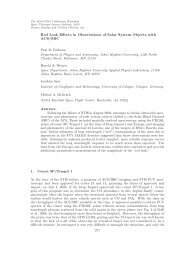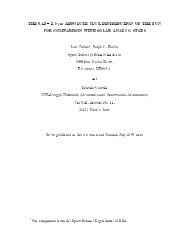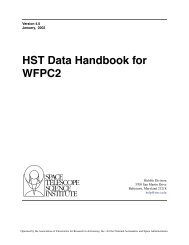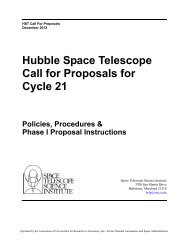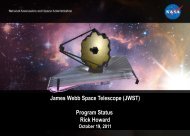STScI Annual Report 2002: A Living Mission
STScI Annual Report 2002: A Living Mission
STScI Annual Report 2002: A Living Mission
Create successful ePaper yourself
Turn your PDF publications into a flip-book with our unique Google optimized e-Paper software.
32 organization<br />
Chris Blades<br />
Bill Sparks, Deputy<br />
Rodger Doxsey<br />
Helmut Jenkner,<br />
Deputy<br />
Office<br />
Peter Stockman<br />
David Hunter, Deputy<br />
<strong>Mission</strong>s Office<br />
Melissa McGrath<br />
Carol Christian,<br />
Deputy<br />
Instruments Division [INS]<br />
INS is home for the scientific and engineering staff that work directly on Hubble Space Telescope, James<br />
Webb Space Telescope (JWST), and future missions. It supervises functional assignments of individual<br />
scientists to each of the three <strong>Mission</strong> Offices and is responsible for career growth and professional<br />
development of its staff, for all personnel decisions, and for establishing and developing expertise in<br />
its technical domain. INS supports Hubble observers to use the science instruments with maximum<br />
effectiveness, providing scientific and technical advice in developing observing programs and interpreting<br />
data. It calibrates and characterizes the science instruments. It facilitates the use of new science instruments<br />
by participating in their development, by capturing and transferring information about instrument<br />
operation and calibration to the Institute, and by coordinating the commissioning of all the instruments<br />
following a servicing mission. � The ACS Branch is responsible for utilization of the Advanced Camera<br />
for Surveys. � The NICMOS Branch is responsible for utilization of the Near Infrared Camera and<br />
Multi-Object Spectrometer. � The Telescopes Branch maintains the Hubble focal plane model, monitors<br />
telescope focus, and supports use of the Fine Guidance Sensors (FGSs) as astrometry science instruments.<br />
It also characterizes the anticipated imaging performance of JWST and its scientific capabilities.<br />
A small engineering team maintains engineering knowledge of the Hubble instruments and spacecraft,<br />
monitors health and performance of the instruments, and tracks the status of their limited-life items.<br />
� The Spectrographs Branch is responsible for use of Space Telescope Imaging Spectrograph (STIS) and<br />
for supporting archival analysis of data from the retired spectrographs. � The WFPC2 Branch is responsible<br />
for use of the Wide Field Planetary Camera 2 (WFPC2). � The WFC3 Branch is responsible for the<br />
Wide Field Camera 3. � The COS Branch is responsible for the Cosmic Origins Spectrograph. � The<br />
JWST Instruments Branch participates in the development of instruments for JWST. � The Data Analysts<br />
Branch supports the technical work of the Hubble and JWST <strong>Mission</strong>s as well as the scientific research<br />
of Institute staff.<br />
Hubble Space Telescope <strong>Mission</strong> Office [HST]<br />
HST is responsible for maximizing the science return from the mission by managing the Institute activities<br />
specific to the conduct of the Hubble Space Telescope program. It develops the overall Institute plans<br />
for Hubble science operations and system enhancements, working with the team leads in the operating<br />
divisions and centers. The Hubble <strong>Mission</strong> Office is responsible for establishing performance and<br />
development requirements, monitoring performance and schedules, and prioritizing the expenditure<br />
of resources. It works with the divisions, centers, and Program Management to develop and monitor<br />
yearly and long-term budgets. It is also responsible for establishing effective scientific, technical, and<br />
operational interfaces with the Hubble Project at Goddard Space Flight Center and associated contractors.<br />
James Webb Space Telescope <strong>Mission</strong> Office [WMO]<br />
WMO collaborates with NASA to develop the scientific, technical, and operational vision for the James<br />
Webb Space Telescope (JWST). It manages the development of the JWST Science and Operations Center.<br />
It works with the community to ensure the best JWST observatory possible within the cost constraints<br />
of this challenging program. It works with the Institute divisions to ensure proper support to NASA, the<br />
science instrument teams, and other JWST partners, including the prime contractor, Northrop Grumman<br />
Space Technologies.<br />
Community <strong>Mission</strong>s Office [CMO]<br />
CMO manages the Institute’s involvement in missions and projects other than Hubble and JWST. CMO<br />
facilitates new initiatives and coordinates their review by the New Initiatives Panel and the New Starts<br />
Group. For missions arising in the community, CMO promotes new applications for Institute products and<br />
services customized to meet specific mission needs. CMO strives to maximize the scientific usefulness of<br />
Institute involvements by engaging scientific staff members directly in the support of community missions.



